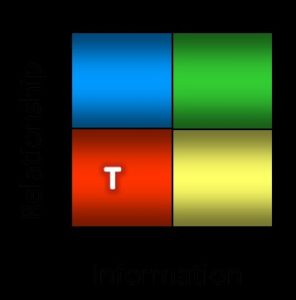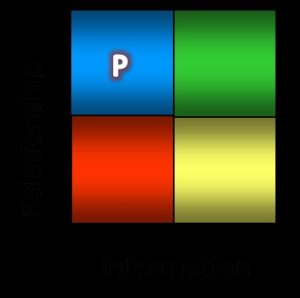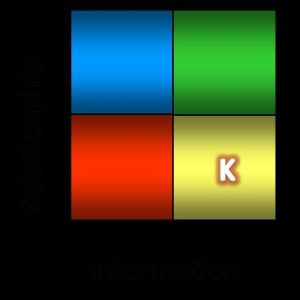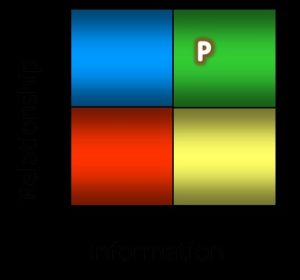The procurement function has professionalized more rapidly than the sales profession:
- They have become the “guardian of the cash” for companies.
- Sales deals with their client, but must contract with procurement.
- Pushed into the “price” vice…..no single sourcing.
- Terms……45 days 60 days 90 days
- Penalties for non-performance
How do organizations deal with this situation? Does it affect the way that salespeople are selling? How should it affect the compensation of salespeople?
The nature of the selling ….. And the required sales compensation measure is different in each quadrant ….. and some salespeople will have customers in all quadrants ….. How do you reward them?
Transactional Phase (Price)

X Axis: Information Y Axis: Relationship
Characteristics of this quadrant:
- Not interested in a relationship.
- Don’t need a lot of information to make a decision.
- Only interested in price… Volume = Discount.
Approach in this quadrant
- Keep costs low – don’t invest
- Measure gross margin
- Compensate for reduction in discounting
Personal Phase (Trust)

X Axis: Information Y Axis: Relationship
Characteristics of this quadrant:
- Strong relationship basis for decisions.
- Salesperson significantly influences results.
- Trust -> Product Claims, Warranty, Delivery.
Approach in this quadrant
- Invest and high levels of customer service
- Measure revenue & margin
- Compensate for growth & product mix
Knowledge Phase (Data)

X Axis: Information Y Axis: Relationship
Characteristics of this quadrant:
- Complex sales requiring knowledge of product.
- Not a lot of time for a relationship.
- Must have the data to support value proposition.
Approach in this quadrant
- Educate, focus on customer needs
- Measure close ratio & strategic initiatives
- Compensate for new product & new customers
Partnership Phase (Value)

X Axis: Information Y Axis: Relationship
Characteristics of this quadrant:
- Everyone wants to be here – Few are.
- You can’t have many. Too many resources required
- Based upon value creation ->B2B basis
Approach in this quadrant
- Long-term planning & investment
- Measure performance versus plan
- Compensate for profitability (EBIT, GM)

In today’s global sales environment, organizations are attempting to closely align cost and return. The best practices results are:
Top 10% of accounts Account Teams & NAM/GAM
Second Tier 50% Direct Sales Face-to-Face * Outsourced/ThirdParty/Channel
Lowest Tier 40% Inside Sales (Manage Accounts) Broader Territory Sales
Telemarketing/ Internet
* For many, a reduction in the number of direct/face-to-face salespeople
Most likely that salespeople will have more than one quadrant in their customer mix….this requires decisions on time investment and compensation:
- Segment on customer value (Criteria: Revenue, GM, potential, product, strategy).
- Allocate resources based upon customer percentage by quadrant.
- Evaluate cost to service & TCO
- Track and monitor reward payouts versus results on measure targets


